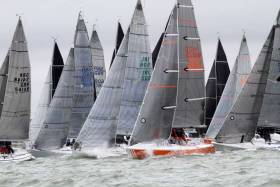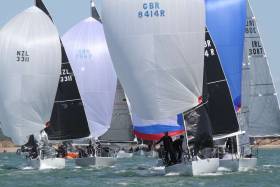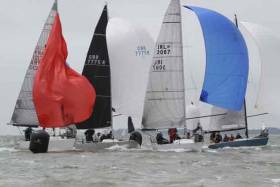Displaying items by tag: Quarter Ton Cup
Winning by a margin of 15 points, the Hamble River Sailing Club team, skippered by Ian Southworth on Protis, won the Quarter Ton Cup in style at Royal Cork Yacht Club on Saturday.
Second place overall in the 11-boat fleet was Cove Sailing Club's Illegal, skippered by Kieran Dorgan.
Third overall went to Courtown Sailing Club's Martin Mahon in Snoopy.
As Afloat reported previously, the eight-race, three-day Cork competition is the first time the Cup has been sailed in the modern era outside Cowes.
Quarter Ton Cup Prizegiving Gallery By Bob Bateman
Ian Southworth and his Protis crew proceeded as expected in Cork Harbour on Friday and now have seven race wins from eight races sailed after the second day of the Quarter Ton Cup at Royal Cork Yacht Club.
 Ian Southworth and his Hamble River Sailing ClThe Cove Sailing Club 'Illegal' (Dorgan/Losty/Marshall) is lying second after the second day of racing at the Quarter Ton Cup at the Royal Cork Yacht Club Photo: Bob Bateman
Ian Southworth and his Hamble River Sailing ClThe Cove Sailing Club 'Illegal' (Dorgan/Losty/Marshall) is lying second after the second day of racing at the Quarter Ton Cup at the Royal Cork Yacht Club Photo: Bob Bateman
Irish crews are making the best of the 20-knot southwest winds that continued for a second day and now hold the next four places overall in the 11-boat fleet.
Cove Sailing Club's Kieran Dorgan's Illegal crew stay second on 17 points, some 13 points off the impressive tally of the Hamble River Sailing Club leaders.
Ten points further back in third is Martin Mahon's Snoopy from Courtown Sailing Club, who has moved up from fourth.
Royal Cork's Conor Phelan is fourth in Anchor Challenge, and fifth is held by Clive O'Shea and Alax Barry in Panic.
 Martin Mahon's Snoopy crew from Courtown Sailing Club are lying third at the Quarter Ton Cup at Royal Cork Yacht Club after day two Photo: Bob Bateman
Martin Mahon's Snoopy crew from Courtown Sailing Club are lying third at the Quarter Ton Cup at Royal Cork Yacht Club after day two Photo: Bob Bateman
UK visitor, Duncan Peace in Pacifist, who was third, is now sixth.
The eight-race, three-day Cork competition is the first time the Cup has been sailed in the modern era outside Cowes.
Racing concludes on Saturday.
Day One of the 2023 Quarter Ton Cup at Royal Cork Yacht Club Photo Gallery by Bob and Chris Bateman
Cove's Dorgan is a Race Winner as Favourite 'Protis' Takes The Lead at Quarter Ton Cup at Royal Cork
Ian Southworth and his Protis crew continue their Irish conquest in Cork Harbour this week with three wins and a second scored in today's opening races of the Quarter Ton Cup at Royal Cork Yacht Club.
 Ian Southworth and his Hamble River Sailing Club Protis crew are leading the Quarter Ton Cup at Royal Cork Yacht Club after day one Photo: Bob Bateman
Ian Southworth and his Hamble River Sailing Club Protis crew are leading the Quarter Ton Cup at Royal Cork Yacht Club after day one Photo: Bob Bateman
Southwest winds up to 20 knots got today's Cup off to a swift start with local interest heightened when Cove Sailing Club's Kieran Dorgan's Illegal crew impressed with a final race win this afternoon to ruin Hamble River Sailing Club crew's perfect scoreline and to lie second overall and top corinthian in the 11-boat fleet.
As regular Afloat readers know, Southworth made swift work of Dun Laoghaire's IRC Three class last Sunday on the Irish east coast before moving to the south coast.
Lying third is UK visitors, Duncan Peace's Corinthian Pacifist crew.
 Duncan Peace's Corinthian Pacifist crew are third at the Quarter Ton Cup at Royal Cork Yacht Club after day one Photo: Bob Bateman
Duncan Peace's Corinthian Pacifist crew are third at the Quarter Ton Cup at Royal Cork Yacht Club after day one Photo: Bob Bateman
The eight-race, three-day Cork competition is the first time the Cup has been sailed in the modern era outside Cowes.
The next best of the Irish is Martin Mahon's Snoopy from Courtown Sailing Club in fourth.
 Martin Mahon's Snoopy crew from Courtown Sailing Club are lying fourth at the Quarter Ton Cup at Royal Cork Yacht Club after day one Photo: Bob Bateman
Martin Mahon's Snoopy crew from Courtown Sailing Club are lying fourth at the Quarter Ton Cup at Royal Cork Yacht Club after day one Photo: Bob Bateman
Racing continues on Friday.
Day One of the 2023 Quarter Ton Cup at Royal Cork Yacht Club Photo Gallery by Bob and Chris Bateman
Southwest winds up to 20 knots will get today's Quarter Ton Cup off to a swift start at the Royal Cork Yacht Club in Cork Harbour.
Four UK visitors are led by the 2021 winner and last week's Dun Laoghaire Regatta 'Volvo Boat of the Week winner', Protis, skippered by Ian Southworth of Hamble River Sailing Club.
The eight-race, three-day Cork competition will be the first time the Cup has been sailed in the modern era outside Cowes. Admittedly, only 11 are competing, but it's still a quality fleet with some top sailors seeking victory.
Southworth made swift work of Dun Laoghaire's IRC Three class last Sunday on the east coast, winning seven races on the trot, so he can be considered warmed up and ready to go.
Irish entries, including Conor Phelan's Anchor Challenge, who won Class Three at June's Sovereign's Cup in style, is racing with Ireland's four-time Olympic keelboat helmsman Mark Mansfield aboard.
Kieran Dorgan's Illegal (second last week in Dun Laoghaire Regatta's Class Three) and Martin Mahon's Snoopy (third) will likely be the main Irish threats to Protis.
 Conor Phelan's Anchor Challenge from Royal Cork Yacht Club Photo: Bob Bateman
Conor Phelan's Anchor Challenge from Royal Cork Yacht Club Photo: Bob Bateman
Another interesting addition to the local foray, however, will be Panic, with both 2004 Olympian Killian Collins and Ireland's top 505 ace Alex Barry aboard.
The event comes to the Irish south coast from the Solent for the first time since the Cup was resurrected 18 years ago.
 Martin Mahon's Snoopy from Courtown Sailing Club Photo: Bob Bateman
Martin Mahon's Snoopy from Courtown Sailing Club Photo: Bob Bateman
The Quarter Ton Cup is awarded to the World Quarter Ton class championships winners between 1968 and 1997 and for the Quarter Ton Classic Revival from 2005 to the present. The fleet’s main centre is on the Solent.
 Kieran Dorgan's Illegal competing at Volvo Dun Laoghaire Regatta Photo: Bob Bateman
Kieran Dorgan's Illegal competing at Volvo Dun Laoghaire Regatta Photo: Bob Bateman
Cork Harbour's Class Three continues to strengthen with the arrival of several Quarter Tonners in the last two seasons.
Overall, the fleet includes some authentic classic designs, including an Albin Express, various Quarter Tonners, a Bolero, vintage J24s, an HB31 and a Trapper 250.
Quarter Tonner Panic arrived from Northern Ireland, Illegal came from Cowes, as Afloat reported previously, and Anchor Challenge, a championship-winning boat (that has had three previous Cork owners) returned to the harbour in 2022.
Royal Cork's 2023 Quarter Ton Cup Notice of Race is Published
The Notice of Race for the upcoming Quarter Ton Cup in Crosshaven, County Cork, July (13–15, 2023) has been released by Royal Cork Yacht Club and marks the return of the Cup to Cork Harbour for the first time in 36 years.
The event will be based on three-day windward/leeward race courses. The NOR also states that at least three races will be held daily.
The large Quarter Ton fleet from the south coast of England is anticipated to visit the Cork Harbour race track, and it's also anticipated that the harbour's active fleet will compete.
As Afloat reported earlier, the event's awarding to RCYC follows a resurgence in Quarter Ton interest in Crosshaven over the past few seasons.
 Quarter Ton racing in Cork Harbour Photo: Bob Bateman
Quarter Ton racing in Cork Harbour Photo: Bob Bateman
Recalling 1987's Cork Quarter Ton Cup
Many veteran Cork sailors recall the "J Class" from the 1960s, which changed into the "1/4 Ton" fleet in the 1970s and 1980s.
The class has a long history with Cork Harbour. Back then, the foundations of the fleet were Ruffians, Sadler 25s, Manzanita, Starflash, and Bolero designs.
For a specific group of RCYC members who competed in the same event back in 1987, the return of the class has brought back some exciting memories from late August and early September of that year.
The "Offshore Race," which saw the 25-boat fleet travel from Crosshaven to the Bulman off Kinsale, then out to the Gas Rigs (in the dark), before returning to Kinsale and Cork Harbour, is the memory that is recalled the most.
For the 24' boats of the time, it was a difficult race with a lot of wind and high waves competing overnight with just four crew members and without the aid of modern GPS.
The Notice of Race is available and is downloadable below. Entry is now available online here
Royal Irish's Niall Dowling is Third at The Quarter Ton Cup as Ian Southworth’s Team Retain Title
From a nail-biting finale, a fitting conclusion to what felt like a long, hard three-day 12 race regatta that enjoyed winds from 5kts to 18kts Ian Southworth and Team Hamble successfully retained the Quarter Ton Cup on the Solent out of Cowes on Sunday.
The Royal Irish's Niall Dowling finished third overall in Per Elisa.
The veteran crew of Protis held off a sustained, spirited challenge from Louise Morton and her all-girl crew on Bullet who finished runners-up as they also did in 2019 when the event was last contested.
In so doing the crew comprising Southworth, John Santy, Lincoln Redding, Mike Stannard and Led Pritchard fittingly marked the 40th anniversary of their boat’s memorable triumph in the original Quarter Ton Cup in Marseille, France when co-skippered by French sailing legend Bruno Trouble.
 Downwind under spinnaker at the 2021 Quarter Ton Cup in Cowes Photo: Paul Wyeth
Downwind under spinnaker at the 2021 Quarter Ton Cup in Cowes Photo: Paul Wyeth
In 1981 Protis’ original title win in the heyday of the class was secured by Trouble and crew at the end of one of the most epic offshore races of the Quarter Tonners’ long history, a 180 nautical miles passage along the coast to Saint Raphael which finished in a 55-60kts Mistral wind.
Both Protis and her nearest rival Cifraline – the only two boats left in the race of the 21 which started - spent the last night of the race sheltering at anchor before finishing back into Marseille the following afternoon.
Team Hamble had an altogether tamer trial today to secure the Quarter Ton Cup for their second successive time. Southworth was making his name winning GP14 and Enterprise dinghy titles 40 years ago when his boat was giving designer Jacques Fauroux a third consecutive Quarter Ton Cup title.
In the pleasant afternoon sunshine on the lawns of the hosts and organising club The Royal Yacht Squadron, he agreed wholeheartedly with Louise Morton that this was an altogether much tougher, more competitive event than when they were first and second in 2019. Each days saw different teams top the leaderboard and six different crews won races.
Kieran Haywood on Blackfun led at the end of Friday and finished fourth overall just three points off second while Saturday’s leader Catch, sailed by Olivia Dowling was fifth overall. A 1,4,2 finish today gave Niall Dowling and crew on Per Elisa third place on the podium, his best Quarter Ton Cup finish yet.
“Without question this was harder than last time.” Smiled Southworth, his longtime cohort Santy chorused “With all the lead changes from Day 1 to Day 2 and then throughout today, the lead kept changing it was really mixed up all the time and everyone had a chance to do well.”
In today’s patchy SSW’ly breezes clean, quick starts from multiple keelboat and dinghy champion Southworth made the telling difference, aided and abetted by a well seasoned crew some of whom he has sailed with for more than 30 years on J/24s and other small keelboats.
 An aerial view of the 2021 Quarter Ton Cup fleet in Cowes Photo: Paul Wyeth
An aerial view of the 2021 Quarter Ton Cup fleet in Cowes Photo: Paul Wyeth
When Protis could get clear off the start line they were uncatchable in the light winds today, as evidenced by their three wins from the last four starts of the regatta.
“The breeze was quite patchy and you had to stay in it. We had one fantastic pin end start but the breeze just folded and we could not get back.” Southworth reported, “We lost our way yesterday in the stronger breeze but were back into it today.”
Runner up Louise Morton, a three times overall winner who as Class Secretary has been the driving impetus behind the class in recent year enthused: “I am thrilled with second. It is such hard racing and we absolutely sailed our socks off. I just cannot think of what we could have done better. My girls sailed incredibly well and just kept us in it all the time. But really what gives me the greatest amount of pleasure is there being so many different winners. It was such a great regatta, so many different leaders and so many different boats winning races. And it was great to make sure it went down to the last race.”
Morton and her crew led the regatta going into the penultimate race by half a point.
“I do feel we should have stopped after Race 10 though……” she joked with Southworth.
Finishing just one point behind Bullet Niall Dowling’s Per Elisa team had their best day today, when it counted. He said, “I am delighted with third it was a fantastic three days racing, great spirit on the water. The light airs helped us a little but every day we learned a little more, and every leg we learned and we were just getting better as the regatta went on.
Top Corinthian ( no professionals on board) team were Edward White’s mainly family crew on the distinctive orange hulled Joker a 1979 design by Alain Jezequel for famous Dutch racer Fred Imhoff. Tenth overall in the 17 boat fleet, Joker won Race 4 across the finish line to take second place on corrected time and were more consistently up racing in the top half for the fleet.
Bowman White commented, “We are overjoyed it has been eight years of trying and we finally have the boat going a bit better. We have done a lot of practice and racing so it is nice to get a trophy and we are sailing her much better. She is a quirky design, long and tweaky. Over the years we have done all the mods but this time it was the same as when we put her away in a barn for 18 months.”
The Bullet Trophy for the boat achieving the most first places went to Protis which won four times, Peter Morton and crew also collecting the Roger Swinney Trophy for the first boat overall with a handicap TCF of 0.906. The Kemp Plate was awarded to Olivia Anne, the Walking Stick for the oldest bowman in the fleet went to Protis’ Led Pritchard and the Concours d’Elegance award for the best turned out boat was awarded to Duncan Pearce’s Pacifist.
2021 Quarter Ton Cup, Royal Yacht Squadron, Cowes
Results after 12 races, one discard
- 1 Protis, Team Hamble 34.5pts
- 2 Bullet, Louise Morton 43pts
- 3 Per Elisa, Niall Dowling 44pts
- 4 Blackfun, Kieran Hayward 47pts
- 5 Catch, Olivia Dowling 51.5pts
17 Boat Quarter Ton Cup Fleet Are Racing in Cowes
Over the next three days on the Solent out of Cowes Ian Southworth and the Team Hamble crew of Protis will do their best to retain the Quarter Ton Cup title that they won on the same waters in 2019, the last time the coveted trophy was raced for.
If they can achieve this and come out top of the white-hot 17-strong fleet that includes three owners who have between them shared the title ten times over the 15 editions contested since the class’s top trophy was rejuvenated back in 2005, overall victory would be an appropriate way to celebrate the 40th anniversary of their boat winning a breezy Quarter Ton Cup in Marseille, France.
“Given the chance we would have liked the opportunity to stage a suitable big celebration ashore here but the way things still are that seems unlikely, so meantime we will have to do our best on the water. But it is worth remembering the boat is the youngest of us.” sagely notes Protis’ Led Pritchard, who along with Southworth, Lincoln Redding, John Santy and Mike Stannard dominated the nine race 2019 championship.
“We are so looking forwards to this regatta. Everyone is.” Southworth comments, “We have done all we can, theoretically, but so has everyone else. But the title could go to any one of six boats.”
Recent preparations did not go completely to plan for Protis, which was built for Bruno Trouble as a development of the Jacques Fauroux designs which won the Quarter Ton Cup three times consecutively from 1979. During the recent windy Vice Admiral’s Cup they lost their rudder and had to withdraw and hastily seek a replacement in order to be ready to race this weekend.
Two times winner Sam Laidlaw and crew of BLT laid down a marker when they won the class at the Vice Admiral’s Cup two weekends ago, although the windy conditions were very much to the liking of their boat which is also a beautifully restored former Fauroux Bullit which originally won the Quarter Ton Cup in 1980.
Winds on the Solent are expected to start out light at least for the first couple of days of the event for which the ambitious target is up to four races a day over Friday, Saturday and Sunday.
Peter Morton and Louise Morton, husband and wife rivals who are longstanding stalwarts of the revived class, have four and three Quarter Ton Cup titles respectively, although Louise’ boat actually won in 2011 when she was sidelined with a broken leg.
Peter ‘Morty’ Morton will race the Gonzalez designed Cote this time. If he were to win it would be his fourth different boat to triumph with, after Espada (Farr) in 2007, Anchor Challenge (Farr) in 2009 and Bullit (1978 Fauroux) in 2012 and 2014. Morty has been making some modifications to Cote over recent weeks and races with Volvo Ocean Race winner Jules Salter, a long time Quarter Tonner fan – with Salter’s two sons Fred 15, and Edward, 18 and Annabel Vose.
“It is just great to have Jules racing with his sons, an experience they will enjoy. This is still the best racing around. It is incredibly close. It is all about how you sail and how you do things and there are so many good boats and crews. It is just too hard to guess who will come out on top. Really there are many boats that have different strengths on different days.” Summarises Peter Morton.
After victories in 2013, 2015 and 2016 Louise Morton will be looking to win for a fourth time. Racing with her very successful Bullet all-female crew comprising Lucy Forester Coles (nee Macgregor), Nicky Walsh (nee Macgregor) Kate Macgregor, Suzy Russell, Colette ichmond (nee Blair) Morton finished runner up to Southworth in 2019 and has been one of the most consistent performers over recent years.
Making its debut after an extensive refit in Cowes will be Duncan Peace’s 1981 Pacifist, a boat he actually designed himself. Peace originally worked with the late Ed Dubois before diverting into different business avenues. He has recently bought the boat he designed and has had it restored with a new deck.
Competition in the Quarter Ton class is extremely close and exacting. With small-time corrections under IRC over a race with a target duration of 45 minutes, winning deltas are usually down to a few seconds here and there. And family rivalries, especially between partners competing on different boats, always add spice to the competition. As well as the Morton household rivalry Niall and Olivia Dowling race Per Elisa and Catch respectively, Andrew Walsh races on Per Elisa while wife Nicky races Bullet, Tom Forrester Coles races on BLT while wife Lucy is also on Bullet. Sam Richmond races Per EIisa and Collette his wife is on Bullet.
“It certainly keeps it all extra interesting.” Smiles Louise Morton.
British Vendée Globe solo racer Pip Hare is also a huge fan of the Quarter Ton Class and has raced at the Quarter Ton Cup since 2013. Despite a tight schedule, heading to Cascais, Portugal where she will join Louis Burton’s team on The Ocean Race Europe, Hare will race today (Friday) on her usual position on Tom Hill’s Belinda.
“It really is the absolute best of British racing. It is scarily close and so much fun I am so sorry not be able to race all of the regatta.” Hare comments.
Racing is being run by the Royal Yacht Squadron, Cowes with the first race sequence planned for 1025hrs each day and up to 12 races scheduled.
Mike Daly's Cobh Pirate originally from Cork Harbour adds Irish interest to the pinnacle event of the quarter-ton class season, the Quarter Ton Cup, starts in less than a week, and it’s set to be an open stage with all of the fleet capable of winning races when the competition gets underway 10-12 June.
One entry, in particular, has piqued the interest of sailing enthusiasts, with the return of the 1980 Quarter Ton Cup winning boat Bullit. In the true spirit of the class, Bullit was recently discovered in Tahiti and has been brought back to the UK by the reigning Quarter Ton Cup champion Sam Laidlaw, where it has been through a major refit to restore it to its former glory.
It has been a herculean effort by the refit team, led by Brett Aarons, to get the boat race-ready and we’ll have to wait and see if they can make it to the start line in time.
Two other ‘Bullit’ design Jacques Fauroux quarter tonners will also enter the event; Louise Morton’s all-women’s team Bullet, and Julian Metherell’s Bullit, whose crew includes the youngest bowman in the fleet in 22-year-old Harry Blowers who will compete in his second Quarter Ton Cup.
The fleet is known for the diversity of its competitors with a number of younger crews entering the class each year to take on the old guard as well as compete alongside some big names of the sport on a level playing field.
Amongst the most experienced of the quarter ton competitors is Derek Morland and Tim Rees, both having competed in the first revived Quarter Ton Cup in 2005 as well as many editions since then. This year the duo will race Genie, a boat borrowed from Peter Morton who will be racing Innuendo.
2019 also sees the return of more familiar faces to the line-up with Olivia Dowling in Catch and Sweden’s Rikard Melander in Alice, both set to make a welcome return to the Quarter Ton Cup after being absent for the last few editions.
Three days of inshore racing with nine closely contested windward-leeward races on the Solent are planned for the fleet which is renowned for its intense competition. PRO Stuart Childerley expects to see some tough competition on the water, and believes the pressure will be sustained from start to finish.
“I expect the competition to be very close,” commented Childerley. “The leader will gradually appear as the series progresses. That boat will be the boat that makes the least mistakes and sails the shortest distance at the best speed possible.
“I think the class is special because there’s a broad range of sailing backgrounds amongst the teams and the boats are all different, yet several of the boats in the fleet should have good expectations.”
The fleet will be based at Cowes Yacht Haven with a full racing and social programme planned including the official prize giving on Wednesday evening.
To follow the Quarter Ton Cup, for the full entry list and for the latest results, visit the official website here
2019 Quarter Ton Cup Expects Intense Competition
The fifteenth edition of the revived Quarter Ton Cup is less than a month away with more than 20 boats expected on the start line come 10—12 June for what is building up to be an intense and intriguing battle.
Three days of inshore racing with three races a day on the Solent are planned for the fleet which is famed for its intense competition on the water and friendly social scene on shore.
Most of the quarter ton fleet had the chance to shake off their sails and get a taste of the competition that lies in store for them at the Vice Admiral’s Cup held off Cowes last weekend, where an interesting form guide started to emerge. Setting the pace was Louise Morton and her team on Bullet, and if their performance is anything to go by, they will be formidable competitors come the Quarter Ton Cup.
“We were pleased to win the Vice Admiral’s Cup as the team on Aguila have won this event for the last four years,” said Morton, who already has an enviable bag of silverware having won the Quarter Ton Cup in 2015 and 2016. “We are looking forward to the Quarter Ton Cup.”
Morton faced stiff competition over the course of the Vice Admiral's Cup from Ian Southworth’s Protis, with the two trading places at the top of the leaderboard throughout the event. After three days of close tussles around the course, Southworth eventually finished just 1.5 points behind Morton, with Tony Hayward’s Blackfun in third place, but on almost double Southworth’s points.
Having won the Quarter Ton Cup for the last two years, Sam Laidlaw’s Aguila will be the team to beat come match week. Aguila didn’t complete the final day of racing at the Vice Admiral's Cup, and a fifth place finish will surely have left Laidlaw’s team with fire in their bellies.
Joining the Quarter Ton Cup fleet for the first time this season is Sir Keith Mills and his newly acquired Cote, and his teams’ credentials are impressive. Top Musto skiff sailor Andy Tarburton is on the bow, Matt Alvarado, a flying fifteen champion is in charge of trimming, with Jules Cole, a BT Global challenge winner in the pit. Mills and his son Alex, both accomplished sailors with TP52 and Fast40 experience, will take turns on the helm.
Also amongst them is the experienced head of Pete Greenhalgh, a four-times winner of the Extreme Sailing Series, who says the team have learnt a number of valuable lessons from the start of their season, which they will take forward to next month’s Quarter Ton Cup.
“It’s been a fun class to sail in. We have done the Spring Champs and Vice Admiral's and find when it’s windy our boat goes well but have yet to find the upwind speed in the light-medium to be competitive enough to stay anywhere near the front of the fleet,” explained Greenhalgh. "We have a great team and we are looking forward to the Quarter Ton Cup. We are hoping with a few modifications we can get into the top five.”
Rumours in Cowes are that the 1980 Quarter Ton Cup winning boat Bullit which was the second of Jacques Fauroux Quarter Ton winners from that design, has recently been discovered in Tahiti and shipped back to the UK for a major refurbishment by an existing Owner. If this is true, this Quarter Ton Cup will be their first event and will be the fourth ‘Bullit’ design Jacques Fauroux quarter tonner in the Solent.
The uniqueness of the Quarter Ton fleet, especially in 2019, is the diversity of the designers. Last year in a fleet of 22 boats, there were 16 different naval architects represented which is unheard of in modern fleets. Back in their day, so many young naval architects cut their teeth in quarter tonners and with the growth of strict one designs and lack of any level rating box rules in small boats, that opportunity simply does not exist.
As well as celebrating a vast range of designs, the fleet is unique in welcoming a diverse range of competitors from trans-ocean racers to world champions, alongside a handful of previous winners and newcomers to the fleet, making for an exceptional line-up. And with almost every team realistically capable of winning races, we can expect plenty of twists and turns come the first start gun.
Two Irish Quarter Tonners in Top Ten of Revival Cup at Cowes
Two Irish boats are in the top ten after the opening day of the 2018 Revival Quarter Ton Cup Regatta, being held off Cowes from 20 to 22 June, got off to a flying start with four cracking races in a steady west-south-westerly breeze of 12-18 knots.
Barry Cunningham's Quest from the Royal Irish Yacht Club in Dun Laoghaire is eighth and Royal Cork's Paul Gibbons' Anchor Challenge is ninth. A third Irish boat in the 21 boat fleet, Mike Daly's Cobh Pirate from Cork Harbour, is 15th.
Download full results below
Although initially overcast, by the start of race three the sun had broken through and the second half of the day produced classic champagne sailing conditions for the 21 strong fleet. With short windward-leeward courses in the Central Solent, Race Officer Rob Lamb kept the pace on to give his customers plenty of fast, furious and fun competition.
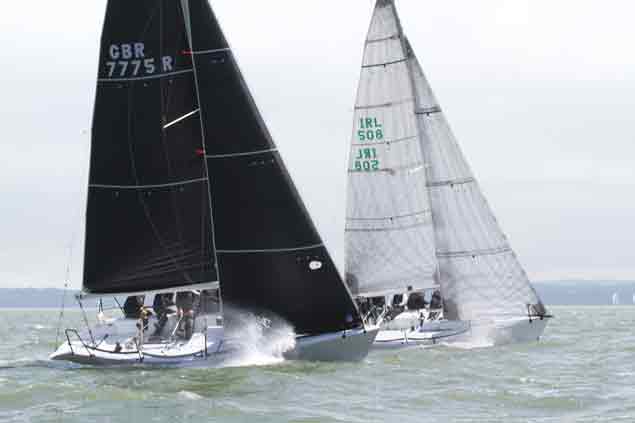 Barry Cunningham's Quest (IRL 508) upwind on the Solent into today's first races of the Quarter Ton Cup Photo: Fiona Brown
Barry Cunningham's Quest (IRL 508) upwind on the Solent into today's first races of the Quarter Ton Cup Photo: Fiona Brown
There’s something of a ballistics theme to the overall standings at the end of day one, with Louise Morton’s 1978 Fauroux designed Bullet taking three race wins and a seventh to give her a three-point overall lead from Julian Metherell’s 1979 Fauroux designed Bullit, which was victorious in the final race of the day. Bullit is on equal points with Sam Laidlaw’s Rolf Vrolik designed Aquila, who sits third overall on countback alone.
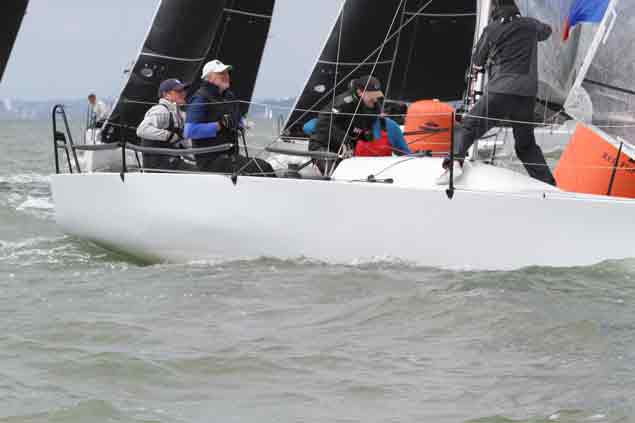 Royal Cork Olympian Mark Mansfield (second from left) is among the crew of Paul Gibbon's Anchor Challenge Photo: Fiona Brown
Royal Cork Olympian Mark Mansfield (second from left) is among the crew of Paul Gibbon's Anchor Challenge Photo: Fiona Brown
Louise and her team put their stamp on the regatta early with a terrific start in race one, which they translated into a handsome lead by the first mark after picking their way cleverly up the right side of the course. Louise’s husband Peter Morton sailing the 1986 McIlraith designed Innuendo, which won the opening race of the 1987 Quarter Ton Cup in Cork, was close on her tail, but an uncharacteristic stumble as they hoisted the kite for the first time saw them spinning out into a classic Chinese gybe and loosing valuable time. With Innuendo out of the running it was Ian Southworth and the Whiskers boys who took second place with Aquila third. After sailing Whisker’s John Santy noted, “We’ve had a fabulous day but it’s incredibly close racing. There are just seconds in it so one slip and you’re out the back door, but as usual we’re loving every minute of it.”
Initially it looked as if Aquila might have the better of Bullet in race two, but a mark rounding misjudgement saw her forced to take a penalty. Bullet went on to win by 35 seconds while Aquila had to be content with second place. Kieran Hayward’s Blackfun, which was launched in 1976 to a Laurie Davidson design and won that year’s Quarter Ton Cup in New Zealand with four straight wins, took third place.
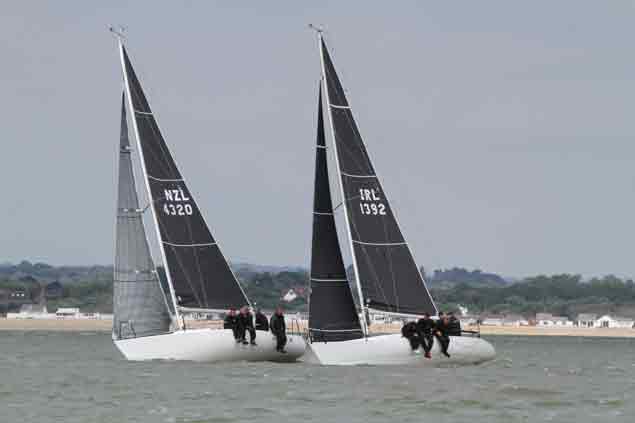 Mike Daly's Cobh Pirate (IRL 1392) Photo: Fiona Brown
Mike Daly's Cobh Pirate (IRL 1392) Photo: Fiona Brown
The sun came out during race three adding that little extra sparkle to an already spectacular day’s racing. Bullet once again ensured she was not only right on the line, but also in clear air – an invaluable commodity in a fleet as tight as this one. She romped home for her third win of the series ahead of Bullit, who took second place by a mere second from Innuendo.
The final race of the day brought slightly lighter conditions and saw Bullet miss her step for the first time in the series. Bullet’s Kate Macgregor explained, “We just missed a few small shifts up the first beat. We managed to gain some places, but it’s so close that it’s hard to fight your way back.” Bullit took full advantage of Bullet’s misfortunes and stormed home to victory from Blackfun with Aquila third, just one second ahead of Pierre Paris’s 1979 Fauroux designed Penguin Playboy.
In the Corinthian Competition for all amateur crews six teams are vying for the victor’s laurels. Pinquin Playboy currently leads Robbie Stewart’s Hellaby, which was designed by Laurie Davidson and finished second to Bullit in the 1980 Quarter Ton Cup in Auckland, by five points with Edward White’s 1979 Jezequel designed Joker in third.
This year’s competition sees the return to the fleet of several old friends including Jan Thirkettle’s delightful Olivia Anne VI, which was built in 1974 to a Peter Norlin design and is a 26’ Quarter Ton version of Norlin’s Scampi Half Ton Cup winner. Jan and her team are no strangers to the Revival Quarter Ton Cup, and after some time off cruising they are delighted to be back on the race course. A second iteration design, still in near original configuration and sailed by a crew of family and friends, they may struggle to challenge their bigger third iteration sisters for the silveware, but that doesn’t stop them enjoying themselves or sailing the boat extremely hard to a creditable 16th overall after four races.
The forecast for the second day of competition anticipates plenty of sunshine and a north-north-westerly breeze in the mid-teens. However, for Friday’s final day conditions are expected to be very light. The Race Committee has confirmed that it hopes to run four more races on day two in case Friday’s light winds limit the number of races possible


























